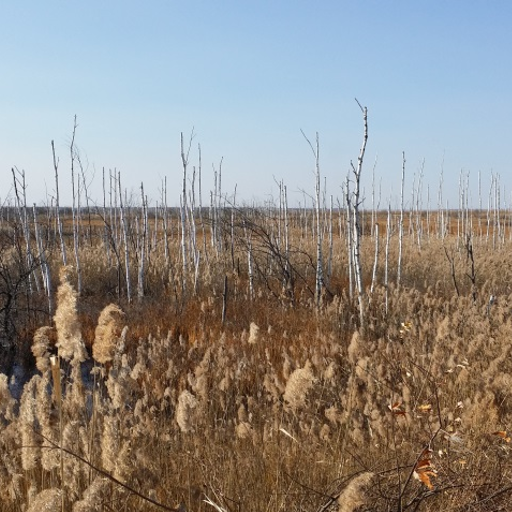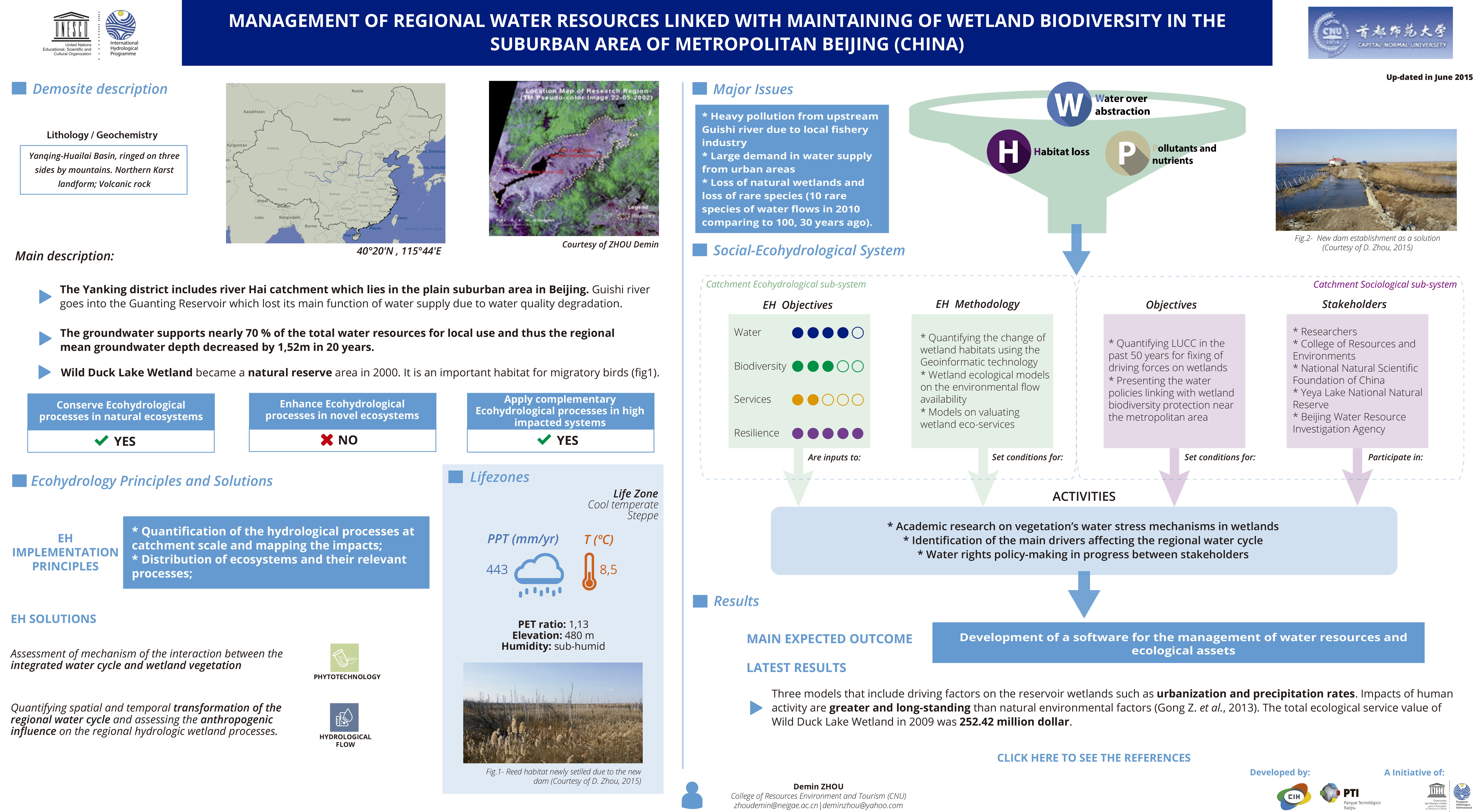MANAGEMENT OF REGIONAL WATER RESOURCES LINKED WITH MAINTAINING OF WETLAND BIODIVERSITY IN THE SUBURBAN AREA OF METROPOLITAN BEIJING (CHINA)

Description
Location


Sketch

Information about lithology/geochemistry:
Yanqing-Huailai Basin, ringed on three sides by mountains. Northern Karst landform; Volcanic rock
Main Description
- The Yanking district includes river Hai catchment which lies in the plain suburban area in Beijing. Guishi river goes into the Guanting Reservoir which lost its main function of water supply due to water quality degradation.
- The groundwater supports nearly 70 % of the total water resources for local use and thus the regional mean groundwater depth decreased by 1,52m in 20 years.
- Wild Duck Lake Wetland became a natural reserve area in 2000. It is an important habitat for migratory birds (fig1).
Enhance ecohydrological processes in novel ecosystem
NO
Apply complementary Ecohydrological processes in high impacted system
YES
This table presents the different categories of ecosystem services that ecosystem can provide, divided in:
Provisioning Services are ecosystem services that describe the material or energy outputs from ecosystems. They include food, water and other resources.

Food: Ecosystems provide the conditions for growing food. Food comes principally from managed agro-ecosystems but marine and freshwater systems or forests also provide food for human consumption. Wild foods from forests are often underestimated.

Raw materials: Ecosystems provide a great diversity of materials for construction and fuel including wood, biofuels and plant oils that are directly derived from wild and cultivated plant species.
Regulating Services are the services that ecosystems provide by acting as regulators eg. regulating the quality of air and soil or by providing flood and disease control.

Local climate and air quality: Trees provide shade whilst forests influence rainfall and water availability both locally and regionally. Trees or other plants also play an important role in regulating air quality by removing pollutants from the atmosphere.

Carbon sequestration and storage: Ecosystems regulate the global climate by storing and sequestering greenhouse gases. As trees and plants grow, they remove carbon dioxide from the atmosphere and effectively lock it away in their tissues. In this way forest ecosystems are carbon stores. Biodiversity also plays an important role by improving the capacity of ecosystems to adapt to the effects of climate change.

Waste-water treatment: Ecosystems such as wetlands filter both human and animal waste and act as a natural buffer to the surrounding environment. Through the biological activity of microorganisms in the soil, most waste is broken down. Thereby pathogens (disease causing microbes) are eliminated, and the level of nutrients and pollution is reduced.

Erosion prevention and maintenance of soil fertility: Soil erosion is a key factor in the process of land degradation and desertification. Vegetation cover provides a vital regulating service by preventing soil erosion. Soil fertility is essential for plant growth and agriculture and well functioning ecosystems supply the soil with nutrients required to support plant growth.
Ecosystem services "that are necessary for the production of all other ecosystem services". These include services such as nutrient recycling, primary production and soil formation.

Maintenance of genetic diversity: Genetic diversity is the variety of genes between and within species populations. Genetic diversity distinguishes different breeds or races from each other thus providing the basis for locally well-adapted cultivars and a gene pool for further developing commercial crops and livestock. Some habitats have an exceptionally high number of species which makes them more genetically diverse than others and are known as ‘biodiversity hotspots’.
Cultural Services corresponds nonmaterial benefits people obtain from ecosystems through spiritual enrichment, cognitive development, reflection, recreation, and aesthetic experiences.

Tourism: Ecosystems and biodiversity play an important role for many kinds of tourism which in turn provides considerable economic benefits and is a vital source of income for many countries. In 2008 global earnings from tourism summed up to US$ 944 billion. Cultural and eco-tourism can also educate people about the importance of biological diversity.
Lifezones

![]()
PPT(mm/yr): 443.0
![]()
T(ºc): 8.5
| Elevation of demosite: | 480.0 meters above sea level |
| Humidity: | Sub-Humid |
| PETr (by year): | 1.13 |
EH Principles
Quantification of the hydrological processes at catchment scale and mapping the impacts
Distribution of ecosystems and their relevant processes (ex: metabolism=water and nutrient uptake and retention; biomass production)
ECOHYDROLOGY ENGINEERING SOLUTIONS
Assessment of mechanism of the interaction between the integrated water cycle and wetland vegetation
 Phytotechnology
Phytotechnology
Quantifying spatial and temporal transformation of the regional water cycle and assessing the anthropogenic influence on the regional hydrologic wetland processes
 Hydrological Flow
Hydrological Flow
Major Issues
- Heavy pollution from upstream Guishi river due to local fishery industry
- Large demand in water supply from urban areas
- Loss of natural wetlands and loss of rare species (10 rare species of water flows in 2010 comparing to 100, 30 years ago).





Expected Outcomes
Development of a software for the management of water resources and ecological assets
Latest Results
- Three models that include driving factors on the reservoir wetlands such as urbanization and precipitation rates. Impacts of human activity are greater and long-standing than natural environmental factors (Gong Z. et al., 2013). The total ecological service value of Wild Duck Lake Wetland in 2009 was 252.42 million dollar.
Contacts
Demin Zhou
- zhoudemin@neigae.ac.cn
- http://english.neigae.cas.cn/
- College of Resources Environment and Tourism (CNU)
- http://english.neigae.cas.cn/

Social ecohydrological system
EH Objectives
EH Methodology
Catchment Ecohydrological sub-system
Objectives
Stakeholders
Catchment Sociological sub-system
Activities